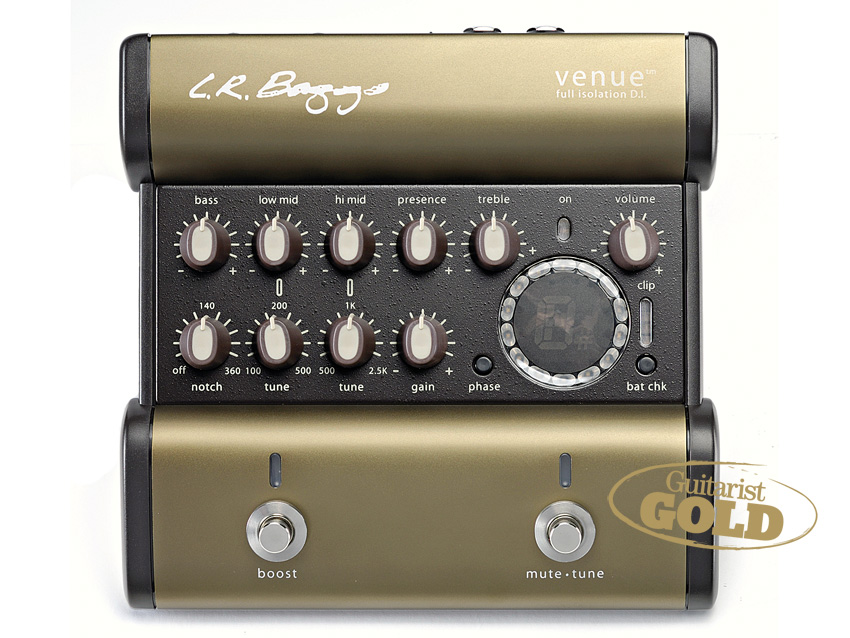MusicRadar Verdict
Whether you see it as a pucker DI box with extras or a preamp with all the toys, if you're a gigging acoustic musician, just buy one - you'll thank us.
Pros
- +
Everything: a fantastically practical design.
Cons
- -
Nothing.
MusicRadar's got your back
It's over a year since we spotted this neat, unique product at the NAMM show in January 2009. "Finally," we thought, "someone's made a preamp 'tool-kit' for the gigging acoustic musician, not the studio or live sound recording boffin."
Why the long wait? The unit only started shipping in late 2009 - we don't know why but, frankly, we don't care. Our initial instincts were correct: if you gig with an acoustic guitar, you need one of these.
Typically well-designed with a small footprint, the unit runs off a single battery or non-supplied mains adaptor. Battery life isn't huge, but the battery-check LED at least lets you see what's in the tank. We'd done five two-hour gigs and two lengthy rehearsals before we changed battery just to be on the safe side.
"If you gig with an acoustic guitar, you need one of these."
The unit boasts a high input impedance (10 meg ohms), so even instruments without onboard preamps should happily work here, and features a five-band EQ section, with sweepable low and hi mid-range, each band with +/- 12dB cut/boost. Feedback-busting is catered for by a single-knob Garrett Null notch filter (proprietary to LR Baggs), plus a phase switch.
Also onboard we get a switchable boost function (you can set your boost level via a small rotary control on the unit's top edge) and onboard tuner. The latter has a large ring of green LEDs around its circular display that meet and introduce a red LED when you're in tune - the note is clearly indicated by a red LED segment display.
A simple FX loop is joined by the ultra important DI output. "This output is transformer-coupled for maximum isolation from noise and ground loop hum," says LR Baggs in the comprehensive manual. "The signal level is set at 0dBu and will work into a 600-ohm or higher input impedance, so you have plenty of signal strength to send down long cables. The XLR output isn't affected by the volume control but is affected by all other controls."
In use
With all the EQs in their centre-notched (flat) positions and the notch filter switched out, it's easy to set your input level via the gain control and clip meter. The volume controls set your output level and, with a lot of EQ boost available, just keep an eye on the input of your destination amp.
To our ears everything sounds very clean and the EQs very natural. The notch filter and phase switch are very effective, especially at smaller gigs where you might be closer to your backline amp than you'd like.
The adjustable boost proved invaluable - its orange status LED always a godsend on a dark stage - and the tuner is sensitive, accurate and very easy to see. Of course, if you're playing through a big PA, it's all you need along with a lead and guitar - just point the soundman to that DI and, trust us, he or she will love you.
This is a truly outstanding piece of gear. We honestly can't think of anything more the gigging acoustic musician would need and everything works perfectly, sounds top drawer and it's already a part of our gigging set-up. Okay, it's not a cheap fix, but then no quality units of its type are and none of the others available include an onboard tuner.
So, for us, it's bye-bye separate pedals and patch leads and hello to improved EQ, DI and superb feedback-busting. Excellent.
Dave Burrluck is one of the world’s most experienced guitar journalists, who started writing back in the '80s for International Musician and Recording World, co-founded The Guitar Magazine and has been the Gear Reviews Editor of Guitarist magazine for the past two decades. Along the way, Dave has been the sole author of The PRS Guitar Book and The Player's Guide to Guitar Maintenance as well as contributing to numerous other books on the electric guitar. Dave is an active gigging and recording musician and still finds time to make, repair and mod guitars, not least for Guitarist’s The Mod Squad.
“I parted company with my trusty Fender Strat, previously owned by Lemmy, and part exchanged it for a flute. It just looked nice and shiny!”: How Jethro Tull's Ian Anderson became rock’s leading one-legged flautist
“Sometimes I am two people. Johnny is the nice one. Cash causes all the trouble. They fight”: How Johnny Cash drew on his own experiences to make his greatest songs
“For those on the hunt for a great quality 12-string electro-acoustic that won’t break the bank, it's a no-brainer”: Martin X Series Remastered D-X2E Brazilian 12-String review











